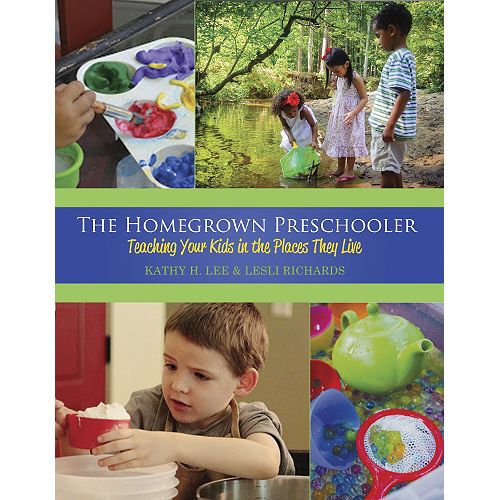
The homegrown preschooler is a beautifully produced soft back book.

The book is divided into two sections: the first consists of nine chapters on the preschooler learning at home covering a variety of topics from learning through play, to making time, organisation and managing in special circumstances such as having children with special needs, chronic illness and adopting a preschool child.
I found that this part of the book was clear and well explained. For example, when explaining that children learn concepts best in a real way, the example of an apple is used. The child could colour a picture of an apple but it is so much better if they can explore the apple using touch, sight, hearing and taste.
The chapter on making time has sample days from different families, ranging from a mother with one child to a home educating mother with six. Useful ideas but equally helpful is the section on "Planning for those days" and well, don't we all have those?
The second section consists of activities in groups:
- home life
- science
- gross motor
- math
- language and emergent literacy
- art
- social-emotional
We used the second part for some ideas for activities. "We" means we. My six year old loves pouring over this book and spent time making a den like the one in the book.
Other activities were putting up a tent and reading books in it before sleeping out overnight.
I had forgotten about magnetic fishing until I read The homegrown preschooler but it was a big hit.
Of course, the science section was an excuse to make more volcanoes, adding glitter so that they looked a bit like cappuccino.
Throughout the book there are recipes, both for food and play materials such as playdough,
sand dough, cloud dough, paints and quick drying clay.
The book has an appendix with links and further reading suggestions as well as instructions for building a plexiglass easel, sand/water table and a light tray. It also contains an activity checklist to allow for planning a balanced range of activities-I found this particularly helpful.
This book is particularly helpful. It has a "can do" attitude and talks about "unavoidable difficulties" as something to "mine for treasure". Whilst many of the activities can involve obtaining items, it also talks about creativity coming out of situations where these are not available.
My plan is to use the activity checklist to work on activities for my four year old, so far,we have only scratched the surface! If anything there are so many activities that it can seem a little overwhelming. In view of this, I'm planning to work through systematically. Yes, many are old favourites but having them together and categorised is particularly helpful for planning.
This book would have been such a help when I started home education, four years ago, with a baby and two year old, as well as an older child. I recommend it for all mothers of preschoolers whether the plan is to send them to school or to home educate them but it is particularly helpful for the many home educating mothers who are trying to balance teaching their older children while not neglecting the preschoolers.
This book retails at $29.95 (£19.48).
To read more reviews of The homegrown preschooler and Global art:activities, projects and inventions around the world also from Gryphon House, visit the Schoolhouse Crew blog.





Some great activities. Some I would find fun myself lol.
ReplyDelete